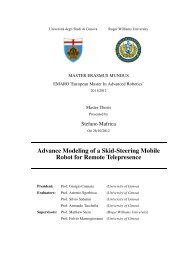SECCM Assessment Plan - Roger Williams University
SECCM Assessment Plan - Roger Williams University
SECCM Assessment Plan - Roger Williams University
Create successful ePaper yourself
Turn your PDF publications into a flip-book with our unique Google optimized e-Paper software.
• Entertain discourse about a central idea: the tension between order and chaos and resulting<br />
dilemmas; and<br />
• Encourage reflection on central questions: Who am I What can I know And, based on what I<br />
know, how should I act<br />
Significant Constituencies of the Programs<br />
Constituencies<br />
The School of Engineering, Computing and Construction Management serves eight constituencies:<br />
1. The <strong>University</strong> at large<br />
2. Our students<br />
3. Parents of students<br />
4. Employers or potential employers of students who might select the program<br />
5. Professional advisory board<br />
6. Our alumni<br />
7. The engineering, computing and construction management profession in general and professional<br />
societies of the specific concentration areas that the program areas offer, and<br />
8. Our faculty.<br />
Each of these constituencies is engaged in some or all of the processes associated with the <strong>SECCM</strong><br />
<strong>Assessment</strong> <strong>Plan</strong>.<br />
Processes Used to Establish and Review Program Educational Objectives<br />
Our curriculum is designed and refined each year to meet our three programs’ objectives while<br />
reinforcing the core values and educational objectives of <strong>Roger</strong> <strong>Williams</strong> <strong>University</strong>. We involve our<br />
eight constituency groups when formulating and refining our objectives.<br />
The <strong>SECCM</strong> <strong>Assessment</strong> Framework establishes the foundation of our continuous quality<br />
improvement philosophy. It provides the context within which we assure defined feedback loop<br />
processes. Within this framework, results from our various assessment mechanisms are used to<br />
improve systems, processes and program components specifically as they relate to individual<br />
program objectives and outcomes.<br />
The <strong>Assessment</strong> Framework includes three interrelated process areas: the processes involved with<br />
defining and refining educational program objectives, processes involved with our assessment<br />
system and processes defining the collection of, and disposition of assessment results. Figure 1.2<br />
presents a visual portrayal of our <strong>SECCM</strong> <strong>Assessment</strong> Framework.<br />
<strong>SECCM</strong> Change Process<br />
Program assessment, while a continuous process, must be periodically evaluated and summarized.<br />
This evaluation is conducted on a semi-annual basis with formal program assessment meetings<br />
attended by the faculty. At this meeting faculty members perform an in-depth review of program<br />
objectives and outcomes using the data collected by the assessment instruments. The action items<br />
resulting from the program assessment meetings are several. These action items include: program<br />
curriculum changes; course evolution; identification of facilities needs; identification of faculty needs;<br />
modification of school and program goals and/or objectives; and, evolution of the assessment<br />
process. The changes made are then assessed during the next assessment period as the process<br />
begins anew. Figure 1.3 provides a visual reference to the discussion of this process.<br />
5
















